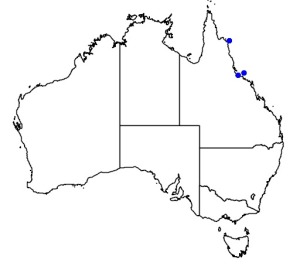
©Anne Hoggett: Bothriaster primigenius from under rubble at North Point, Lizard Island. Longest radius is 3.5 cm.

©Anne Hoggett: Bothriaster primigenius from under rubble at North Point, Lizard Island. Longest radius is 3.5 cm.

©Anne Hoggett: Bothriaster primigenius from under rubble at North Point, Lizard Island. Longest radius is 3.5 cm.
Colours
Distinguishing features
A small, solid 5-armed starfish that is concealed within the reef during the day. Colouration is variable. Five apical plates are conspicuously raised and the pentagonal area between them may be coloured differently to the rest of the disc. There is a deep pit in each interradius on the upper surface.
Bothriaster primigenius was recorded in Australia for the first time by Rowe and Gates (1995) from material off Broadhurst Reef and Townsville in 27-45 metres depth. Coleman (2007) records Australian material from shallower depths.
Yamaguchi (1975) has suggested that this form is the juvenile of Choriaster granulatus. Some oreasterids do change remarkably as they grow (e.g. Culcita novaeguineae) but a growth series does not appear to have been published for Choriaster granulatus to establish that this is the case. Synonymy of Bothriaster primigenius with Choriaster granulatus has not (yet) been made (WORMS accessed 14 Jun 2020).
Size
- Up to 4.5 cm (longest radius)
Depth range
- Depth range data is not yet available.
Synonyms
Distribution
Web resources
References
References that assist with identification
- Coleman, N. (2007). Sea Stars: Echinoderms of the Asia/Indo-Pacific Neville Coleman's Underwater Geographic, Springwood, Qld. Australia.
- Marsh, L.M. and J. Fromont (2020). Field Guide to shallow water seastars of Australia. Western Australian Museum, Perth.
Other references
- Rowe, F.W.E. and J. Gates (1995). Echinodermata in: Zoological Catalogue of Australia. Vol. 33, xiii, 510 pp. Wells, A. (Ed.). CSIRO, Melbourne, Australia.
- View all references







